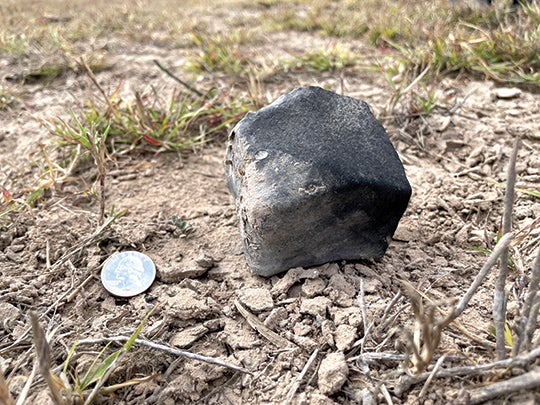A South Texas Meteor Shower
Sonic booms and a fireball led Linda Welzenbach Fries to find four meteorites.

Spring 2023
By Hilary C. Ritz
The last of three February fireballs seen around the world, falling on back-to-back days, was accompanied by a series of sonic booms in the skies over South Texas. The next morning, Feb. 16, the Next Generation Weather Radar system of the National Oceanic and Atmospheric Administration (NOAA) recorded falling materials, and a preliminary report posted on the NASA website showed evidence that meteorites might have made it to the ground.
Linda Welzenbach Fries, a meteorite expert and science writer in Rice’s Department of Earth, Environmental and Planetary Sciences and the former meteorite collections manager at the Smithsonian Institution, leaped into action. Within hours, she began the 350-mile drive to the area in the Rio Grande Valley where the sonic booms had sounded.
She was accompanied by Marc Fries, her husband and a planetary scientist at NASA Johnson Space Center’s Astromaterials Research and Exploration Science Division, as well as the manager of Meteorite Falls, a NASA website that uses weather radar imagery to plot projected landing sites.

During the Fries’ long drive, additional resources came in: videos, wind information, and more data from NASA and NOAA. “As it turns out,” Welzenbach Fries explained in a blog post detailing the discovery, “the altitude and speed were not typical.” Most asteroids and meteoroids intersect Earth at up to 72 kilometers per second, whereas this space rock was moving at closer to 9–12 kilometers per second, and it survived to a lower level in the atmosphere. It may have been this unusual approach that caused the sonic booms to be “strong and widespread,” she wrote.
Another factor might have been the object’s material. “Stoney materials tend to fail and explode from forces exerted on the leading edge of the object,” she wrote, and “this is what happened to the object in South Texas.”
Upon arriving, the Fries spoke to the landowner of the impact area, who consented to their search and agreed to donate one of the fragments to a scientific collection. Their hard work paid off: The Fries discovered three “fully fusion-crusted” meteorites and one fragment, all believed to have been part of a meteoroid that weighed an estimated 1,100 pounds prior to breaking apart in Earth’s atmosphere. “Fusion crust is the residual melted rock that ‘fuses’ to the surface of the rock, analogous to the glaze on pottery,” Welzenbach Fries explained.
A fourth fragment was found late Feb. 18; this piece “is a light gray color that sparkles from the finely disseminated metal grains spread throughout” and has been brought to Rice for analysis and classification.
As Welzenbach Fries wrote, “Study of asteroid remnants such as these enhance our understanding of the origin and evolution of our solar system.”
